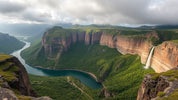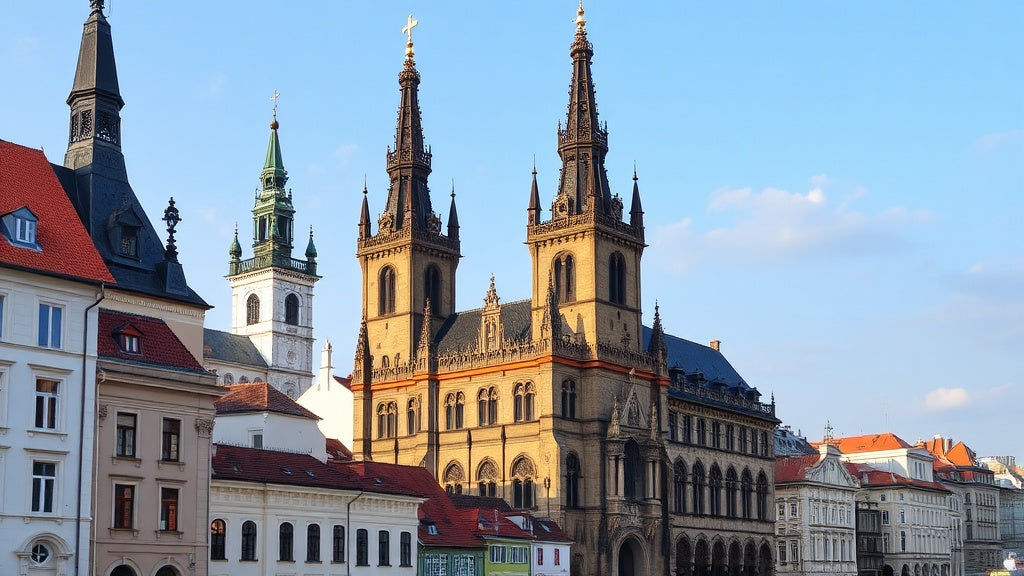
"Explore 25 Unforgettable Natural Wonders That Will Leave You Speechless"
, by Unboxify, 9 min reading time

, by Unboxify, 9 min reading time
Massive glaciers, staggering mountains, plains dotted with wild animals: We sure live in a big, beautiful world. While pinpointing all of Mother Nature's greatest hits could take a lifetime, these out-of-this-world landscapes and awe-inspiring wonders, from Arizona to Antarctica, need to move to the very top of your travel list.
The tallest waterfall in the world, Angel Falls in Venezuela, makes for one of the most spectacular sights imaginable. Shooting off the summit of a table-top mountain, the falls plunge 807 meters uninterrupted to the jungle below, with much of the water turning to mist before it reaches the ground. Due to its remote location in Canaima National Park, Angel Falls is quite challenging to visit, though its stunning setting and awe-inspiring scenery make it well worth the effort.
Situated at the base of steep cliffs on the northeast coast of Ireland, the Giant’s Causeway is a natural rock formation that indeed looks as if it were fashioned by giants. The honeycomb formation of hexagon-shaped basalt columns appears too geometrically perfect to have been shaped by nature. It actually took 60 million years of tectonic plate movement, lava flows, and erosion to fashion the stepping-stone columns into their present shape. Cliff-top trails offer great views of the rocks, with a flight of steps leading down to sea level.
Dominating and defining the northwest of Kaua'i, the Nā Pali Coast is one of Hawaii's most famous and photographed sights. Its gigantic jagged cliffs rise to 1,200 meters above the sparkling waters of the Pacific Ocean, with scenic beaches and coves hidden below. As the rugged terrain is so inaccessible, the only ways to visit are by hiking, kayaking, or helicopter, with phenomenal panoramas wherever you look.
As the highest mountain in the world, Mount Everest attracts climbers of all levels, from well-experienced mountaineers to novice climbers willing to pay substantial sums to professional mountain guides for a successful climb. Although other eight-thousanders such as K2 are much more difficult to climb, Mount Everest still presents many inherent dangers, such as altitude sickness, weather, and wind.
One of the most famous and phenomenal sights in Norway, Pulpit Rock overlooks the lovely Lysefjorden. Formed during the last ice age, the sheer cliff towers 604 meters above its surroundings, offering staggering views of the deep, dark waters and dramatic landscapes below.
In Southern Jordan, Wadi Rum is a desert valley known for its breathtaking scenery. There are no permanent settlements in this secluded desert region, but nomadic tribes do occasionally pass through. This otherworldly area boasts sandstone mountains and towering granite cliffs. Visitors can ride a camel across the amazing desert and camp out under the clear, star-filled sky.
The deepest and oldest lake on Earth, Lake Baikal is reputed to boast some of the clearest and cleanest waters around. Containing more water than all the Great Lakes in North America combined, Lake Baikal is nicknamed the 'Pearl of Siberia.' Whether it’s ice skating across the surface in winter or hiking along the scenic shoreline in summer, Lake Baikal is a nature lover's dream.
Located in the middle of the Indian Ocean, the idyllic Maldives archipelago is spellbindingly beautiful. Celebrated for its high level of luxury and emphasis on the slow life, this low-lying island group is perfect for honeymooners. With designer accommodation and underwater restaurants, the Maldives offers an unparalleled relaxation experience, along with diving excursions to keep things interesting.
Canada’s oldest national park, Banff, is chock full of awesome scenery. Set amongst the Canadian Rockies' beauty, the park contains several beautiful lakes, including Lake Louise and Moraine Lake. It’s a good place to see glaciers, ice fields, and wildlife, such as elk, deer, moose, and bears. Banff draws millions of visitors annually for winter sports, and summer hiking and camping.
Located in the Andes Mountains, Salar de Uyuni is the largest salt flat in the world. The expanse of salt creates an unending white landscape during the dry season, but the area is most breathtaking in the rainy season when it is covered in water, creating a spectacular and surreal landscape. Salar de Uyuni is also a major breeding ground for flamingoes.
The granddaddy of American national parks, Yellowstone, is the oldest in the United States and the world. Known for erupting geysers such as Old Faithful, boiling hot springs like the Grand Prismatic Spring, and even the Grand Canyon of the Yellowstone, this place is a true icon of must-see nature.
Made up of some 275 different cascades, falls, and drops, Iguazu Falls on the Argentine-Brazilian border is the world's largest waterfall system. Devil's Throat Canyon is the highlight, best witnessed from the Brazilian side's viewing platform. With lush rainforest surrounding it, the falls are a treat to visit. Visitors can take boat trips along the Iguazu River or explore the nearby paths and trails.
The Sahara is the world’s largest hot desert, covering most of Northern Africa. Contrary to popular belief, large sand dunes form only a minor part of the Sahara. Most of the desert consists of largely barren, rocky plateaus with very little sand. The Sahara receives less than three inches of rain a year on average.
If you want to get a glimpse of what prehistoric animals may have looked like, head to the Galapagos Islands. Home to giant tortoises and iguanas, these islands were the impetus for Charles Darwin’s book, On the Origin of Species. This archipelago of 18 major islands, about 550 miles off the coast of Ecuador, was formed by volcanic action.
Pamukkale, meaning “cotton castle” in Turkish, is an unreal landscape in western Turkey, famous for its white terraces. The terraces are made of travertine, a sedimentary rock deposited by water with a high mineral content from the hot springs. People have bathed in its pools for thousands of years. The ruins of the ancient Greek city Hierapolis can still be seen at the site.
Located in northwest Hunan Province, Zhangjiajie National Forest boasts some of the most impressive and spectacular landscapes in China. Part of the Wuling Mountain Range, the scenic area is famous for its thousands of pillars and peaks. Often shrouded in mist, these karst formations look incredible, with sparkling rivers, lakes, and waterfalls found throughout the area.
An incredible natural phenomenon, the Northern Lights appear when there is solar activity, creating captivating colors, shapes, and swirls. The best chance to spot them is in winter when the nights are longer. Besides watching them out of your window, you can also take tours into the wilderness to see the lights from secluded, light-free spots.
The largest coral reef system on Earth, the Great Barrier Reef is simply colossal. Stretching for over 1,400 miles, it is remarkably visible from space. Snorkeling and scuba diving are the best ways to experience the joys of the rich underwater world, while boat trips, kayaking, and helicopter rides offer views of the reef’s gargantuan proportions.
Antarctica is the coldest, driest, and windiest continent on the planet, with the highest average elevation of all the continents. Although 98% of it is covered by ice, Antarctica is technically a desert. Sea life here includes penguins, blue whales, orcas, and seals.
Mount Bromo is an active volcano in East Java. At 2,329 meters, it is not the highest peak of the massif but is the most well-known. The top of the volcano has been blown off, and the crater inside constantly belches white smoke. It is surrounded by a sea of fine volcanic sand, creating an unsettlingly unearthly effect.
Victoria Falls dwarfs Niagara with its colossal curtain of water stretching 1,708 meters, reaching a height of 108 meters. Nestled on the border between Zambia and Zimbabwe, Victoria Falls truly needs to be seen to be believed.
Renowned the world over, the Grand Canyon is one of the largest canyons on Earth. Whether you visit the North, South, East, or West Rim areas, it’s always a giant sculpture of light and shadow. With a whole host of trails and viewpoints, and even the opportunity to reach down to the canyon floor, the Grand Canyon is awe-inspiring.
Located in northeastern Vietnam, Ha Long Bay is a scene from a fantasy story with its thousands of limestone karst islands. An overnight boat trip is a spectacular way to experience the beauty of the bay and see many of the islands.
The Amazon rainforest is an awesome piece of nature, covering about ¾ of the Amazon River basin. It is the world’s largest tropical rainforest, loaded with unique flora and fauna.
The Serengeti ecosystem in northwestern Tanzania hosts the largest mass movement of land mammals on the planet. Every year, one million wildebeest and 200,000 zebra make a 300-mile round trip from the Southern Serengeti to the northern edge of the Masai Mara National Reserve in Kenya. The Great Migration is one of the most exceptional natural wonders of the world.






